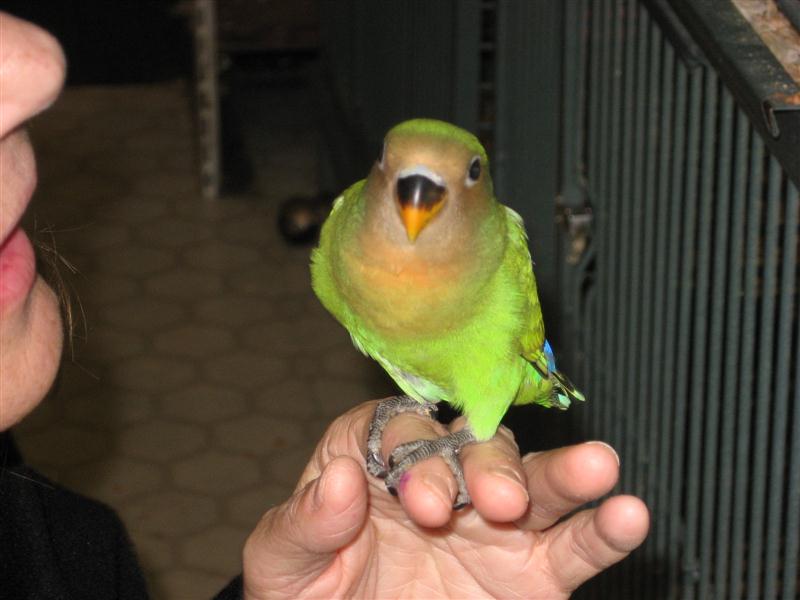
RETURN TO HOME PAGE
FEEDBACK

|
February
2010
RETURN TO HOME PAGE FEEDBACK |

"Siri," whose gender at five weeks still remained a mystery, went home
to her new family in mid-January. She--or he--may want to attend
Alvarado School someday.
Photo by Sally Smith
By Heather World
Siri is in love. While lovebirds across Noe Valley share dinner and kisses this Valentine's Day, she will be standing on one foot and making a chewing sound.That's because Siri, a recent resident of the Animal Company on 24th Street, is a true lovebird, the kind with beak and feathers, and when she moves her beak back and forth and chews softly while standing on one leg, she's telling her new "mom," Leslie Zwemer, that she's happy.
"She bonded to my husband immediately, but she goes to me, too," says Zwemer, noting that Siri has displayed other signs of affection, such as nuzzling her hair.
Zwemer, who teaches kindergarten at Alvarado School on Douglass Street, spent a month's worth of lunch breaks visiting her little lovebird at the pet store and waiting until she was big enough to move to her new home in mid-January.
Or his new home. Zwemer doesn't know Siri's sex, but she's paid the Animal Company the $30 fee to send a drop of blood from the bird's foot to Davis for DNA testing.
But Siri is more than just a pretty (peach) face. She's also a lot of work.
"It's not something you just put in a cage and it looks pretty in your living room," says Zwemer, who cuts fruit, boils eggs, and shells peas because lovebirds must eat soft, fresh food in addition to seed. Occasionally, she has to clean the entire birdcage in her bathtub.
A smaller cousin to the parrot, lovebirds are smart and can understand language, though they don't speak. They can even be toilet-trained, says Zwemer. Full-grown, they are about five to seven inches long, usually with a green body and a colorful head. Siri's body is mostly bright apple-green.
Some people buy lovebirds in pairs, but those birds may not stand on one foot in their owner's company.
"A pair won't bond to people," Zwemer points out. That's because the two lovebirds are smitten with each other.
For now, Zwemer and her husband are focused on keeping Siri's 50 grams of weight stable or growing. She was a small bird to begin with and birds can lose up to one-third of their weight when they leave their siblings.
"Birds can die quickly if they lose weight," Zwemer says. If her weight dips, Siri will have to go back to the pet store and live with other birds who will stimulate her and make her eat.
Rick French, owner of the Animal Company, says caring for a lovebird isn't dramatically different from caring for any bird. "They're really nothing unusual," he says.
They are somewhat rare these days, however. Not many people are breeding lovebirds at the moment, so he doesn't get many in the store. When they do come in, they are young--about two weeks old--and need hand-feeding, which is standard for birds in the store. They can live to be 12 to 15 years old, he says.
"It's a good starter bird for someone who has never had a bird," he says. "They're cute and real personable."
There is no Valentine's Day rush on lovebirds as there are on rabbits at Easter, but French discourages potential customers from buying birds impulsively any time of the year.
" You get a feel for people and whether or not they're interested in getting a pet for a long time," he says. A detailed discussion of bird care can dissuade the impulse buyer.
Not all impulses are bad, though. Zwemer got her first bird when her husband found an escaped parakeet while walking home wondering what he should get his wife for her birthday that day. Mana lived with them for eight years.
After Mana came Lully, Zwemer's adored first lovebird.
"The bird was so bonded to us," she says. "My husband could hold him in his hand and roll him over and pet his stomach. That's really rare for a bird to have that much trust."
Zwemer was devastated when Lully died last year. Her kindergarten class comforted her with letters, and one girl made a bird's nest with eggs.
"They knew, and they were so compassionate," she says.
She has sent an e-card to those students, now in first grade, to thank them and introduce them to Siri.
"For those first-graders, it's learning about loving and losing," she says.
For her current crop of kindergartners, Zwemer has screened a video about Siri and the care of a bird. She even took individual students to meet the bird when she was still at the store.
Now that's true love.